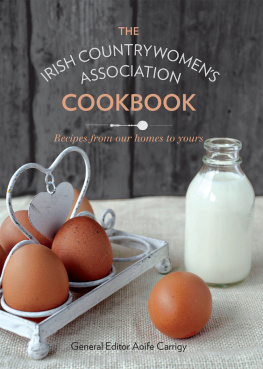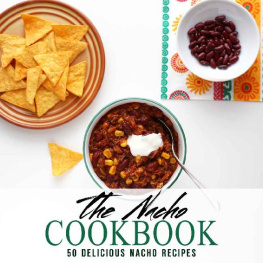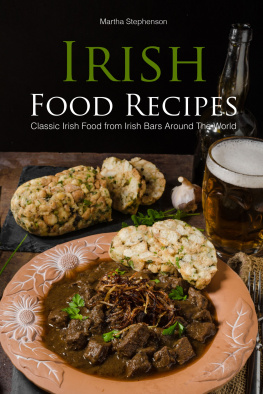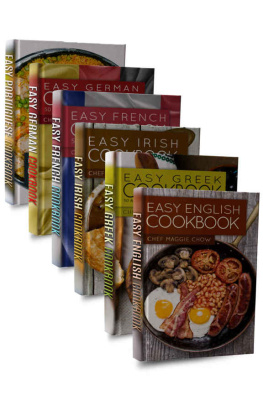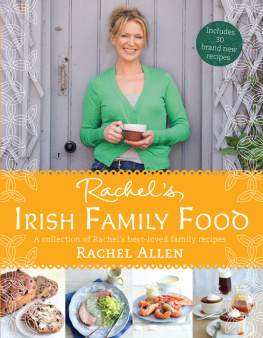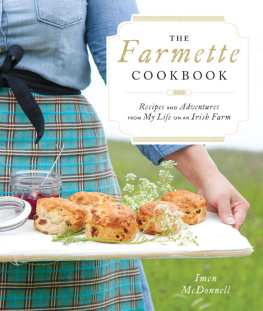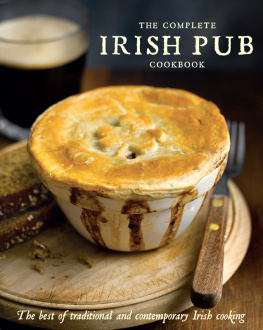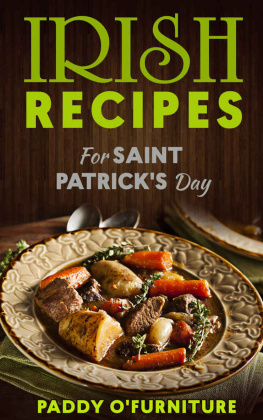THE
IRISH COUNTRYWOMENS
ASSOCIATION
COOKBOOK

Recipes from our homes to yours
General Editor Aoife Carrigy
GILL & MACMILLAN



Introduction

O ver the 100 years of the history of the Irish Countrywomens Association, a variety of local cookbooks have been written by individual ICA Guilds and their members. The aim of the earliest books produced was to be a practical guide to help women improve their culinary skills. These early books were passed down through families from one generation to the next. I am lucky enough to have a very well-used and well-loved ICA cookery book, Bantracht na Tuaitha: 19101960 Golden Jubilee Cookery Book, as part of my familys heritage. When I came into office as National President of the ICA, we felt the time had come to ask my fellow members to join me in contributing some of the wonderful recipes that we use every day in our homes to make up a national cookery book of the ICAs favourite dishes.
We wanted to include dishes featuring produce local to our area and recipes enjoyed in a family for generations alongside modern ideas picked up along the way, and in doing so to build up a new collection of recipes that span the length and breadth of the country. And we wanted to pepper these with practical tips for saving time and money, for getting the best results every time and for cooking for special diets in order to share the wealth of our members experience and to preserve this knowledge for future generations.
We in the ICA are very proud of our heritage and of all the milestones that we have collectively achieved over the last 100 years. This cookery book is not only a celebration of the wonderful ingredients and produce available in this great land, but also of our colourful history, our families, our local communities.
When the ICA was established in 1910, its aim was to improve the standard of life in rural Ireland through education and co-operative effort. Since its beginnings the ICA has been part of all of the key developmental activities in food and its production in Ireland. Up until the late 1920s, potatoes, cabbages and onions were the only vegetables grown and cooked throughout Ireland. The ICA bought and distributed a wide variety of seeds, and taught members how to grow and cook these new vegetables at what was the first ICA summer school, held in Sliabh na mBn, Co Tipperary in 1929.
In the 1930s these ICA classes expanded to cover poultry and egg production, cheese-making and bee-keeping to enable members improve their diets and earn money from the sale of their home produce. In response to Irelands tuberculosis epidemic in the earlier part of the last century the ICA encouraged members to keep goats whose milk was free from TB infection, and goats milk depots were set up around the country to enable members to trade.
By 1947 the ICA was involved in helping small producers to collectively market their home produce by setting up a nationwide network of Country Markets. In the 1950s the rural electrification of Ireland transformed the kitchens of Irish women and their families. Members of the ICA toured the country with a Model Farm Kitchen mobile unit, demonstrating the greatly improved cooking facilities now available. In the 1960s the ICAs Turn on the Tap group water scheme gave rural families the basic necessity of running water inside the home, improving hygiene and cooking as a result.
Now in the 21st Century, food and the joys of cooking continue to be an integral part of ICA life. We continue to offer cookery and gardening classes at An Griann, our adult education centre in Termonfeckin, Co Louth where RTEs ICA Bootcamp was filmed. In 2011 we joined forces with TV chef and food writer Edward Hayden, who embarked on a county-by-county road show of cookery demonstrations, an initiative that has proved extremely popular with members right across the country.
In todays busy modern lives, the importance of a family meal cannot be overstated. It is around the family table that we learn so much about our values, where we right the wrongs of the day and discuss our problems and hopes for the future. The family meal is central to our communities and their wellbeing. The ICA Cookbook will help you make this experience the best it can be, and help us all rediscover the simple pleasures of a home-cooked meal made with local produce that is in season and good for our health.
As we have sung in our ICA song for the last 100 years, our land is a rich and rare land, she is a fresh and fair land. Let us enjoy what is all around us, both rich and fresh, and let us celebrate our heritage through the simple pleasures of home-cooked food.
Liz Wall
National President of the Irish Countrywomens Association
A NOTE FROM THE EDITOR, AOIFE CARRIGY
C ontained in the following pages is a unique collection of recipes focused on tried and tested dishes from the homes of ordinary women from all over the country. Some of these women prefer to cook their food from scratch every time, down to using home-made stocks, sauces and pastries. Others believe life is too short to boil bones or roll your own puff pastry; these women have fridges, freezers and larders well-stocked with reliable fall-back ingredients and have no problem reaching for a bottle or opening a packet to save time. Some would consider these shortcuts to be cheating, others see them as pragmatic routes to delicious dishes. Some wouldnt dream of using a microwave; others cook their fish, vegetables and even their cakes in them. The women of the ICA have never been shy of holding their own opinions, and these recipes give voice to a broad range of culinary schools of thought.
We are bombarded today with ideals of the perfect home-maker but the reality is that often we want to know how to cheat without compromising on flavour. There are other times when we want to dedicate the time to developing a new skill, so that our fridges, freezers and larders can become well-stocked with our own home-made fall-backs. This cookbook aims to satisfy both of those demands, and much else in-between.
We have also included dishes from Marie McGuirk and Edward Hayden, two of the chefs who work with the ICA on a regular basis and who pass on their culinary knowledge as tutors at An Griann adult education centre. But for the most part these are real recipes from real women, some of whom may have trained in home economics, some of whom were trained by their grannies (many of them ICA members too), many of whom learnt from experience by cooking for their younger siblings or their growing families.
As you might expect there are lots of very traditional recipes tucked throughout these pages, many with interesting twists that take into account the changes in how we eat. Irish stew no longer needs to be cooked for hours before it is palatable, as tender lamb is available year round. Deep freezers mean bread and butter pudding is now less of a necessary frugality for using up stale bread, and more of a beloved classic and a steady supply of fresh fruit means we can now play around with what we put into it. Indeed, in some cases we have included two different approaches to the one idea just to illustrate that there are many ways to scratch an itch.

